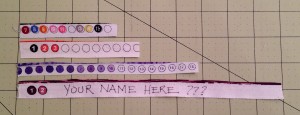Yesterday, Abby Glassenberg of WhileSheNaps delivered an eye-opening post of behind-the-scenes information about the money in fabric design in our industry. Please go read it… I’ll be waiting for you when you’re done. And a continued thank you to Abby for researching and writing such important posts.
I woke up in the wee hours this morning fretting about this, and here’s what I was fretting about: WE must stop agreeing to work for negative income.
At Quilt Market, just two weeks ago, the result of the Quilting in America 2014 Survey was presented by F+W, A Content + eCommerce Company. The major data point is that Quilting is a $3.76 BILLION industry. Yes, BILLION. To be told that there’s almost $4B of cash floating around in Quiltdom, and then to read that there are fabric companies that effectively force their designers into penury via footing the entire bill of Quilt Market marketing obligations is… just… appalling. Abusive. Manipulative. Just plain WRONG.
And I lost count of how many times I heard during market “I don’t know who’s getting the $4B but it sure isn’t me.”
Look – this isn’t about the companies (fabric or otherwise) that take care of their people. This is about those that don’t. If you are so desperate to see your name on the selvedge that you will sign a questionable dotted line, then you will live by that questionable contract (and really, is the “fame” worth it?) But here’s the thing: because you are willing to sign, it tells the company that what they are offering is good enough. So the bar stays low for anyone coming behind you. It’s the same thing I argue about pricing handmade goods – if you are willing to give it up for the “work for free” price, then you are educating the customer that “work for free” is the going rate. Which screws us all, you included.
These companies are not going to offer you a better deal out of the goodness of their hearts, any more than a craft fair customer will double your asking price for the sake of good karma. We are not going to get better contracts unless we refuse to sign the bad ones. And my guess is that if enough of us pass on the bad contracts, and the company faces Quilt Market with little new stuff to show, then they’ll get motivated to up their game.
The quilting industry started its growth back when we began the fight for Equal Rights. Its initial population was founded on women who were brought up to be nice, and that pressure to be nice above all else, and especially above being business-savvy people, is still extreme. I know it can feel “not nice” to push back on a contract, especially when you’ve worked hard to achieve the offer of one. But a contract that screws you over isn’t one you (or our industry) deserves.
And in case you are reading this and thinking “I don’t design fabric so it doesn’t apply to me,” well, think again. If you knew which company treated their artists like this, would you buy from them? Would you encourage them to mistreat their people with your hard-earned money? I hope not…. many of us boycott several brands and chains for less.
We are, as always, in this together. If we demand better, we can achieve it for us all. If we take care of others as we rise, then we all rise. I believe we really can change our industry, but we really have to do it together. As Abby says at the end of her post “This kind of alliance can only happen when we speak up.”
So I’m speaking up. We truly Are $ew Worth It.




OMG, you are sew right. AGAIN
Thanks, Sam. There are a lot of layers to this same story, including the parts about who is paid what for creating our cotton fabrics, from seed to shelf. It’s an old story and only gets more positive very very slowly…
My first husband served on an aircraft carrier, and he was fond of saying that it takes a while to turn around a large boat. We’re in a large boat, and we can’t turn it overnight. But I hope we can put the idiots on notice that we’re playing with the steering wheel.
There is a VERY large fabric store in the lakes region of the state that I live in that has begun offering longarm quilting services. There advertised prices are from $.0175 to $.0225/SI MORE than what we longarmers in the rest of this small northeastern state are charging! The response from almost all of my colleagues is “Oh, that’s way too much money to be charging!” My response? WooHoo, thank you so much KSQ, you just gave me a big raise. What is wrong with us that we are willing to make LESS than subsistence wages so that we can do a job we love?!?
I really do wish I knew which companies were forcing the designers to foot the bill for market. I was appalled when I saw what they actually make per line.
The same attitude is prevalent towards quilt teachers at big shows (that are businesses) that do not pay for transport and accommodation. If they expect teachers to work at their shows (especially overseas ones that draw large numbers of attendees) why aren’t they prepared to pay for the cost of the teachers being there?
An even more important question is why are teachers prepared to accept that they have to pay their own way to work at these shows? The nebulous advantage of “exposure” shouldn’t be the answer.
I read came across Abby’s post yesterday, glad to see you are also discussing it. I knew it was probably bad but good grief! I have worked with people publishing in magazines and books and know they (guess this includes you) don’t get paid enough but it is the mindset we need to change. Thank you for bringing it to everyone’s attention.
I was very appalled to read that article online yesterday and find out that some of the companies we buy from can treat their designers so badly. I know there are companies that treat their employees and designers well. I would really like to know which is which so that I can make my fabric choices accordingly. There is and should be plenty of discussion on this matter post market, and those of us that work in the industry as well as quilters and shops should work towards supporting the firms that treat their contributors correctly.
I am a long time long arm quilter. I refuse to charge lower rates than I do just because the local competition chooses to work for less. I know what my quilting is worth, and I have many repeat customers that are willing to pay for my rates because of the quality, variety, creativity, advice and workmanship they receive from me. I believe its a partnership, between the customer and the quilter and it should be the same between the deisgner and the fabric houses.
Love this post! Keep leading the crusade for better pay for creative people. Anyone who makes something from their mind and with their talents is a priceless resource, and should be treated as such.
Thoughtful. Thank you once again for speaking up and encouraging us to as well.
I read that article last night. I was shocked that designers could come out of a new range owing money. How can a company possibly demand a designer attend market but not cover any of the expenses?
And absolutely, if I knew which companies were that stingy, I would avoid them.
Almost went off at a family member the other day who demanded a free quilt from me because she loved the pictures I’d posted online. Yes, we quilt because we love it. We make gifts for friends and family, and gifts for strangers in need because we love them. But I’m sure as s**t (please excuse my being Australian) not giving something away because it’s demanded. Of course, she was horrified by reasonable sale price and then asked if there was a “family” rate for labor. Well, enough of my rant. We are so worth it. People who don’t believe so, aren’t.
It has bothered me greatly since reading the post yesterday. There are a bunch of quilters who are putting puzzle pieces together, which could inevitably mean a/some fabric companies will have less customers. I think it’s disgraceful that yet again, artists are being paid substandard fees for doing what they are best at.
I don’t understand why we as artisans are so willing to accept less than what we deserve. Do you think an attorney would accept less? Car mechanic? Doctor? I think not! It’s an uphill battle but one we must win if we want validation.
It is disgraceful what little fabric companies are paying there artists,
If you ask me if the companies are so money clingy , I would happily pay an entrance $1 per yard if I was %100 assured it was to go directly to the designer,
As a way of saying your work is amazing,,,!,love your art, keep the magic happening!
Hell I pay more them an extra $1 went it goes out of print and becomes hard to find why should the people not being the work reep the rewards.
So unfair and then to expect them to pay there own way,!,
That is not on at All
Pick up your act fabric companies.. You know who you are.
If I knew the companies doing this I would not buy from them…. how can we find out???
[…] Sam Hunter at Hunter S. Designs also has something to add, as part of the “We Are $ew Worth It” campaign. […]
Not sure if you went to QuiltCOn, but there was a panel of fabric designers there, talking about how to get fabric lines. They were asked directly about how much a line could be expected to make, and things got very testy, with the implication that this was a rude question to ask, and the person who asked was shut down hard. They never answered the question, either.
Thank you, as always, for adding your insights to the discussion, Sam! Abby’s post struck very close to home for me, and challenged me to rethink the ways I’m approaching this industry and what I really want out of my design career.
I would be very interested in to see what actually goes in to producing a yard of fabric. I know the retail markup isn’t very high, and obviously the designers aren’t getting a huge cut, but I wonder how lucrative the entire business is, and whether there is really that much money to go around. I love these types of posts, because they bring these issues up to the consumer as well as the potential designer, and when we have a consumer base that understands the costs involved, they often (I hope!) also tend to be more willing to pay what something is actually worth.
It’s terrible to learn that some companies treat their designers this way, but WHY are their names protected? How can we buyers-but-not-designers punish those bums if the designers involved won’t tell us which ones to boycott and write scathing letters to?
Unfortunately this a very real situation throughout the sewing industry. Shops pay employees and teachers poorly and exploit them, and from what you are saying it is going all the way up. As most of us are independent contractors we have little leverage as individuals and few legal rights.